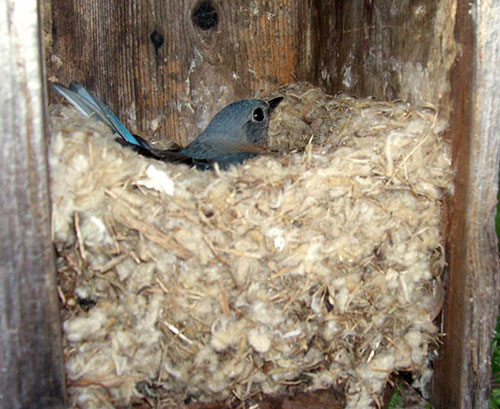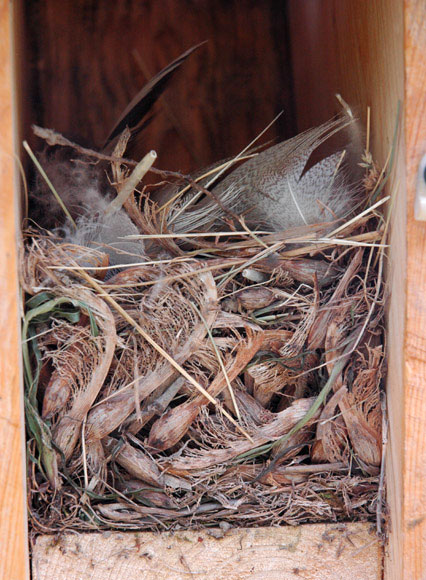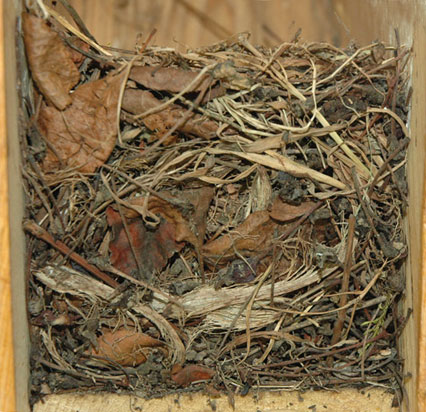Not Your Typical Nests

This photo of a female Eastern Bluebird sitting on a nest made of cattail (Typha latifolia) fluff was taken in 2007 at Penn State in Harrisburg, PA by Andy Ohrman, President of the Bluebird Society of Pennsylvania. He did not see the bluebird construct the nest. He did monitor the box, and the bluebird family fledged successfully.
Andy indicated that there are pine trees in the area, but this bluebird chose cattails from a small nearby pond, which is very good warm material for a cold Spring. The nest will be added to the BSP nest collection. It will be interesting to see if a cattail nest appears again in the future.
Tree Swallows were nesting in this box (above) in 2006. Photo by Shari Kastner of Berlin, Wisconsin. She indicated the nest was in a suburban area with various trees (pines, maple, etc.) cut grass, small ponds and flower beds. I have never seen a Tree Swallow nest with maple seeds in it, although there are plenty of maples in my area. Tree Swallow nests in CT are made with dried grass or pine needles. I wondered whether another creature (a rodent?) added the maple seeds to the nest which was then used by a TRES. However, the box is mounted on a metal pole (no baffle) but does not look like it would be readily accessible to a rodent.
After these birds nested, Shari cleaned the box out, and Eastern Bluebirds nested in it, in a nest also made of maple tree seeds with leaves and grass, below. Jenny of Southern Maryland reported seeing a bluebird getting maple seeds from the gutter and putting several in a nest.
Sometimes birds will use a nest made by another bird or animal, so unless the birds are seen actually carrying the unusual nesting material into the box, it’s hard to be sure they were the “creators.” For example, an abandoned Eastern Bluebird nest (see photo) was used by a Black-capped Chickadee, possibly after a failed nesting attempt elsewhere. The only modification made was addition of some fur to the nest cup. In another case, I found a Black-capped Chickadee nest used by Tree Swallows, with the only addition being a few feathers.

Thank you Andy and Shari for allowing me to post your incredible photos.
MORE INFORMATION & RESOURCES:
|
|
Cavity Nester Nests, Eggs and Young Photos and Bios. Also see Nest ID Matrix (contents) and Egg ID Matrix (color, spots, etc.)
Select bird name (alphabetical):
Previous Pictures of the Week: © Original photographs are copyrighted, and may not be used without the permission of the photographer. Please honor their copyright protection. If you would like to use a photo for educational purposes, you can contact me.
- Tips for photographing cavity nesters
- June 11, 2006 – Great Crested Flycatcher
- June 19, 2006 – Snake Lick
- June 26, 2006 – House Finch Nest
- July 3, 2006 – Tree Swallow in Flight
- July 17, 2006 – Bluebird Battle
- July 24, 2006 – Bear Attack
- August 1, 2006 – Neglected Nestboxes (House Sparrow nests)
- August 14, 2006 – Threesome (Bluebird Babes)
- August 28, 2006 – Peering (flicker)
- January 2007 – New Hill Trail (Sialis)
- February 12 2007 – Sharp-shinned? Hawk feeding on dead starling
- February 19, 2007 – Joe’s Cafe (Suet/Mealworm Feeder)
- March 25, 2007 – Sunflower Eater
- February 2007 – Snags & Suet (Pileated Woodpeckers)
- May 2007 – Birdcam Shots and Birdcam Photo Album
- May 12, 2007 – Carolina Wren nest in a boot
- May 25, 2007 – Batman Bird (Tree Swallows)
- June 2007 – Bluebird nest of cattails, one with leaves, and a TRES nest with maple seeds
- June 20, 2007 – Nine Egger (Tree Swallow nest)
- June 27, 2007 – Black-capped Chickadees (funny and serious photos)
- July 7, 2007 – Anting and Sunbathing
- Red-shouldered Hawk perching on nestbox
- November 18, 2007 – Western Bluebirds at the Spa
- March 15, 2008 – Under Construction – Eastern Bluebirds Building a Nest
- April 9, 2008 – Bluebird Battle in PA
- April 10, 2008 – Mouse Surprise
- April 15, 2008 – Bluebird News (nest in paper box)
- April 23, 2008 – My personal nightmare
- April 25, 2008 – Brave White-breasted Nuthatch
- April, 2008 – How an egg hatches
- May 3, 2008 – Newborn Blue (baby hatching)
- May 3, 2008 – Brave Blue (female on nest)
- May 14, 2008 – House Wren Havoc (eggs pecked)
- May 25, 2008 – House Wren Takeover (of nest, more pecked eggs)
- May 29, 2008 – Take Your Pick (parents feeding fledgling)
- June 10, 2008 – That Look Belongs in a Holster (female MOBL)
- August 23, 2008 – Cat on Nestbox
- September 28, 2008 – HOSP on the House
- October 10, 2008 – Cuddling nestlings (taken in summer time)
- October 27, 2008 – HOSP in flight
- October, 2008 – Possible double and dwarf egg in one nest
- December 16, 2008 – The Next Generation (children building boxes)
- January 22, 2009 – Blue with Cold
- January 28, 2009 – Prothonotary Warbler on a camper | Nest building PROW | PROW nesting in tree cavity
- May, 2009 – To Kill a Mockingbird (Snake eating mockingbird – may be disturbing)
- May 21, 2009 – Should I Stay or Should I Go Now? (Titmouse nestling in box)
- May 25, 2009 – Which of these is not like the others? (Cowbird egg)
- May 23, 2009 – The Honeypot at the end of the rainbow (bumblebee nest)
- June 20, 2009 – House Wren nest decorated with Western Bluebird feathers
- June 20, 2009 – Wonderful WEBLS of WA
- June 20, 2009 – Bluebirds of Bickleton
- July 12, 2009 – Hairy Shrimp (newborn bluebirds)
- July 2009 – Diet (bluebird with earthworm in beak)
- July 2009 – Bluebirds nesting outside of cavity
- July 19, 2009 – HOSP on Holiday
- July 20, 2009 – Pink bluebird eggs
- August 2, 2009 – Pinkies (baby mice)
- August 2, 2009 – En garde (male bluebird in box)
- September 29, 2009 – 1917 instructions for bird house construction
- I forget when – Rainbox
- April 11, 2010 – nuthatch bark
- April 12, 2010 – My first white egg
- April 12, 2009 – TUTI nest by Keith Kridler
- May 2010 – TUTI newborns
- May 2010 – Christmas Chickadee
- May 2010 – Bluebird and Chickadee eggs in the same nest
- June 2012 – Paparazzi
- April 2013 – Under Construction – Titmouse nestbuilding
- July 2013 – Pink Bluebird Eggs
- July 2014 – Cowbird egg in Eastern Bluebird nest
- July 2014 – Newborn HOSP
- July 2015: Patience Pays (Male Eastern Bluebird)
You cannot begin to preserve any species of animal unless you preserve the habitat in which it dwells. Disturb or destroy that habitat and you will exterminate the species as surely as if you had shot it. So conservation means that you have to preserve forest and grassland, river and lake, even the sea itself. This is vital not only for the preservation of animal life generally, but for the future existence of man himself—a point that seems to escape many people.
-Gerald Durrell, The Nature Conservancy
